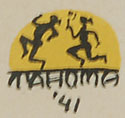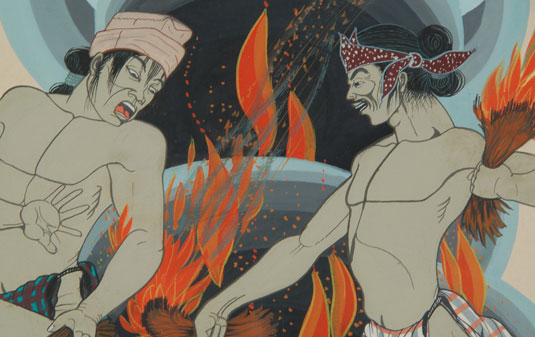Original Diné Painting of a Navajo Fire Dance [SOLD]
+ Add to my watchlist Forward to Friend
- Category: Paintings
- Origin: Diné of the Navajo Nation
- Medium: gouache
- Size: 14-1/4” x 9-3/4” image:
22” x 17-3/8” framed - Item # C3564A SOLD
When the Japanese attacked Pearl Harbor in December 1941, Native American young men hastened to volunteer to serve their country. The numbers of Navajo servicemen and women represented one of the largest percent of any ethnic groups in the U. S. to serve. The entire football team of the Santa Fe Indian School marched together to enlist after their homecoming game. The Selective Service stated that 99 percent of all eligible Indians had registered for the draft, a much larger percentage than non-Indians. Quincy Tahoma, claiming he was 21, when actually he was 24, registered to serve but was declared 4F Status because of a deformed arm.
Left behind when all his friends had departed Santa Fe, Quincy Tahoma (1917-1956) Water Edge full-heartedly dove into pursuing his art career. Photographer T. Harmon Parkhurst had a photography studio in the plaza area and invited Tahoma to paint and display his art at the studio. The New Mexico Museum of Art frequently exhibited paintings by Native artists. Tahoma benefited from both these venues.
In this painting, Tahoma illustrates a portion of the Navajo Fire Dance, a dance at the end of the nine-day Mountain Chant. To start the dance, many young men drag great trees for a central fire, which rapidly turns into a fierce flaring, crackling, and roaring heat. When it becomes its hottest, suddenly the loud burring call of the fire-dancers fills the air. The following is a description of the Fire Dance as witnessed in the 19th century by Washington Matthews.
"The men, racing in a circle round the fire, close to the unbearable heat, whooped like demons and beat their own bodies and each other's with the flaming brands. One man beat the bare back in front of him until it slipped away. Then he flared his brand over his own back, showering sparks, he straddled it as he ran, he turned and threw its flames over the man who followed him. They washed each other's backs with flame. They leaped so close to the fire that their bare feet seemed to be treading on live coals. The figures, following each his own devices, together made a painting such as Doré might have done for Dante's Inferno: pale inhuman figures, capering in the firelight, bathed in the red glow and the showers of orange sparks, always calling that queer suggestion of flickering flame. It seemed to last a long time; actually until the cedar brands were well burned out. Then each man dropped his smoldering bark and, still trilling loudly, ran out of the corral. Intense, brilliant, savage.
"As the dancers left, spectators swarmed in to pick up bits of the burned cedar, sure protection against danger of fire for the year to come. By this time the east was showing white, that comfortless early morning light which makes everyone ghastly. Even brown Navajo faces looked gray. White people appeared as at the end of a long illness or a terrific debauch. The fire was burning low again, but nobody built it up. Then the chief medicine-man came in. He had not been seen all night, his task having been to sit in the hogan, chanting. Now he entered, accompanied by his assistants, and chanted while they scattered water on the fire at the four ceremonial points. Then young men tore gaps in the circle of branches, one opening toward each direction. As the medicine-man went back to the hogan, they demolished the whole corral, leaving the branches on the ground. Day was full by that time, and the circle of prostrate branches was like a stage with all the scenery removed and the curtains rolled up. The only important matter seemed breakfast, especially coffee."
 Tahoma illustrates the Fire Dance with only two participants but as many as 14 may participate. He perhaps did this so he could show more detail in his presentation rather than fill the painting with 14 figures of less detail. His presentation of the smoke above the flaming fire is most impressive in its Art Deco style. This painting is signed and dated 1941 in lower right.
Tahoma illustrates the Fire Dance with only two participants but as many as 14 may participate. He perhaps did this so he could show more detail in his presentation rather than fill the painting with 14 figures of less detail. His presentation of the smoke above the flaming fire is most impressive in its Art Deco style. This painting is signed and dated 1941 in lower right.
Condition: appears to be in original condition but has not been examined out of the frame
Provenance: from a family in California
Recommended Reading: Quincy Tahoma, The Life and Legacy of a Navajo Artist by Charnell Havens, et. al.

- Category: Paintings
- Origin: Diné of the Navajo Nation
- Medium: gouache
- Size: 14-1/4” x 9-3/4” image:
22” x 17-3/8” framed - Item # C3564A SOLD



